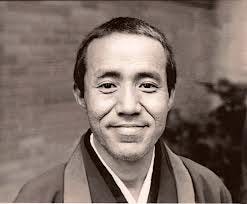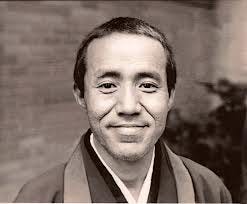[Los Altos Hills, California. December 1976]
A five-day Zen retreat. The wake-up time was 3:40 AM, and the evening before, I offered to take responsibility for the wake-up bell. I knew this would at least give me the motivation to get up at all. When my alarm clock rang at 3:30, I noticed that the somewhat mountainous climate made the nights very cold. Dutifully, I went around the sleeping rooms to wake everyone up.
Sitting. Forty minutes in half-lotus or Burmese style, preferably without moving the legs. In spite of the uncomfortable position, I fell asleep for a moment. Then I woke up as the pain in my legs grew. The cold and the pain took turns keeping me busy. Most students—as the meditators were called—enveloped themselves in blankets. I did not have one. "Why didn’t I take a blanket?" went through my mind. "I didn’t think of it while waking up the others, and moreover, walking under a blanket like a phantom is not exactly the dress code for waking people up." Daydreaming about these and similar thoughts. But mostly, there was pain and the cold. The bell indicating the end of the sitting period was a relief.
Walking meditation. As usual, 10 minutes, performed very slowly. In the dark hall, lit by a few oil lamps, one could see the vapor coming out of each person’s mouth or nostrils. We were like horses in a meadow during a cold winter night. It was allowed to go to the bathroom during the walking rounds, and I sneaked out of the meditation hall to get a blanket. After the walking round, we did a second sitting session, again for 40 minutes. I did not really get warm, despite the blanket. Sleepiness and stiffness were also bothersome. This time, the cold won over the other disturbances. I stayed awake.
After the second sitting, it was breakfast time. Still shivering, I went up to the dining hall, following the others. Eating was done in a formal way using oryoki. Three bowls
of food: rice, fried tofu with onions, and vegetables. Not bad, especially because it was steaming warm. At the end, each of us had to clean the bowls in a ritualistic way. Hot water was poured into them, and with our chopsticks and a kind of spatula we had to wipe them clean. Then, we had to drink that water. My mind considered it as "used dishwater," making me gag at it. Other students drank it obediently, and I forced myself to do the same. Actually, its warmth was nice.
In the meantime, it had become light. We went back to the meditation hall. Feeling somewhat better, I continued. Sitting session. Walking round. Sitting. Walking. Sitting. It became warmer at last. Now it was the pain that was most bothersome during the sitting sessions. Walking. Sitting. And so on. In this way, the day passed. The next morning, it was as cold as the first one. The motivation to get up had diminished. No longer bothered by ideas about a dress code, I took the warmth of the bed with me when going for the wake-up round. Sitting in the meditation hall, this time pain and sleepiness were the disturbances. Only for me, it seemed. During the practice, the group was concentrated and serious. No one showed the slightest sign of wanting to quit.
The students were varied: artists, former hippies, housewives, university students, and other nice people, all of different ages. Looking at them, now transfigured again in the steaming horses, questions arose. "There must be a very serious reason," I wondered, "why we are doing this; or else we are all completely mad!?" This was Buddha's puzzle: "What is meditation all about?" I did ponder over it during the next sitting session. But then, the pain brought me back to the here and now.
Again, I pulled myself through the day. For personal reasons, I could stay at the retreat for only two days. At the beginning, the friendly teacher, Kobun Chino Roshi (1939-2002), had agreed to this. That evening, I left. Back in the world, I was happy to be out of the place. The earnest discipline had impressed me. But, to be sure, it had not attracted me. "So why is one doing this?" and Buddha's puzzle remained.





